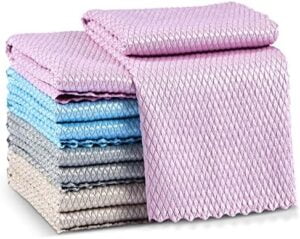Helpful Guides on each Category

Fish scales have been a by-product of fishing for centuries, but did you know that these small, translucent structures have a variety of practical applications?
From traditional medicine to modern technology, they have proven to be versatile and valuable resources.
In this post, we’ll explore 19 important uses of fish scales that you might find surprising
What are Fish scales Made of?
The composition of these flat translucent pieces varies depending on the species of fish, their age, and environmental factors. For example, some fish species have scales that are thicker or harder than others, and the mineral content of their scale can change over time.
They are solely made of a protein called collagen. This makes up a significant portion of the skin, bones, and connective tissues in fish and other animals.
Collagen gives the scales their strength and durability. Additionally, fish scales also contain minerals such as calcium, phosphorus, and magnesium, as well as trace elements like iron, zinc, and copper.
These minerals are important for maintaining the structural integrity of the scale, as well as for various biological processes in the fish.
Uses of Fish Scales

The uses of this structure are numerous, this is a short list of the many uses In this post;
- To tell the age of a fish
- For Medicinal Uses
- Cosmetics and Makeups
- Food Industry
- Clothing and textile Making
- Jewellery Production
- Production of Fertilizer
- Arts and Crafts Application
- Environmental Science
- Biomedical Engineering
- Electronic Components
1. They Tell the Age of the Fish
Experts determine the age of a fish from its scale. They reveal important information about the fish’s growth and life history. As fish grows, so does the scale. Patterns and structures of this scale help determine the age of the fish.
Ageing fish through its scale is called scale reading or scale annuli analysis. This is a brief breakdown of how it works;
- Scale Collection. A sample of scales is taken from the fish, usually from the area near the backbone.
- Examination of scales: The scales are then examined under a microscope or magnifying glass to identify the growth rings, also known as annuli. These growth rings are formed each year as the fish grows and they can be counted to determine the age of the fish.
- Counting the annuli: The annuli can be counted by tracing the pattern of growth rings along the length of the scale. In some species of fish, the annuli are clearly visible, and the age of the fish can be determined relatively easily. In other species, the annuli may be more difficult to discern, and the process may require more time and expertise.
- Comparison with a reference scale: In some cases, the age of the fish can be confirmed by comparing the sample scale to reference scales from known-aged fish.
Read more on this here: Determining the Age of Fish (E1774) – MSU Extension
2. Uses in the Food Industry
This is not a popular food ingredient, but there are a few limited applications in the food industry.
Their uses include; the preparation of Fish stocks, Caviar, cooking oil production, flavour enhancers, decorative food ingredients, food thickener and desserts.
i. Fish Stock Preparation
Fish stock, soups, stews, sauces, and other dishes are simmered with powder from these hard skin covers and other ingredients such as vegetables and herbs to extract flavour and nutrients.
ii. Caviar Production
Caviar, a high-end food product made from the eggs of sturgeon and other fish species use fish scales in preparation.
To make Caviar, remove scales from the fish before the eggs are harvested. They add flavour and texture to the caviar.
iii. Cooking Oil Production
Fish scales can be processed to produce fish oil, which is used in cooking and as a dietary supplement. Fish oil is rich in omega-3 fatty acids and has been linked to various health benefits.
iv. Used as Flavor Enhancers
They flavour certain dishes like soups and stews. The scales are usually dried and ground into a powder that can be used to season the food.
v. Decorative Ingredients in Dishes
Fish scales are used as a decorative ingredient in some dishes, such as sushi and sashimi. They create a unique and attractive appearance, and they can also add flavour to the food.
vi. Used as Food Thickeners
The scales can be processed into a powder and used as a food thickener or added to soups and sauces to give them a smooth and creamy texture.
vii. Preparation of Deserts
Fish gelatine is made from them. A popular ingredient in desserts, candies, and other sweet treats.
3. Health and Medicinal Uses

Asia and Europe use Fish scales in traditional medicine for centuries.
There is a belief that they have anti-inflammatory and pain-relieving properties which treat conditions such as rheumatism, arthritis, and skin diseases.
In addition, some people believe that fish scales can improve blood circulation, boost immunity, and promote overall health and well-being.
i. Biomedical Engineering
Fish scales have even found their way into the field of biomedical engineering. The scales have a unique structure that makes them ideal for use in medical implants, such as artificial tendons and ligaments. The scales are tough and flexible, making them well-suited for use in the human body.
ii. To Heal Burns and wounds
Fish scales have been used in traditional medicine for their wound-healing properties due to the presence of collagen. Collagen is a protein that helps in tissue repair and wound healing.
Read more on this: Fish scales have healing potential – Food Processing
iii. Skin Health Benefits
Being rich in essential fatty acids and other nutrients, they can be beneficial for the skin. Some traditional medicines use them as a natural remedy for skin conditions such as eczema and psoriasis.
iv. Joint pain relief Uses
Fish scales are also used as an ingredient in traditional medicines for joint pain relief. Some studies suggest that they contain compounds that have anti-inflammatory and pain-relieving effects, making them useful in the treatment of conditions such as rheumatoid arthritis and osteoarthritis.
Although, the medical application of this substance has not been proven.
4. Economical and Industrial Uses of Fish Scale
I. Fish Scales Used as Fertilizers
Don’t let fish scales go to waste! These scales are packed with essential nutrients like nitrogen, phosphorus, and potassium that plants need to grow. Using them as fertilizers can give your crops a boost, resulting in higher quality and yields.
They are natural and sustainable alternatives to chemical fertilizers and are also budget-friendly. You can easily source them from fish processing industries, reducing the need for expensive chemical fertilizers.
Simply apply the scales to your soil, and watch as the plants absorb the nutrients, thriving and flourishing.
ii. Cosmetics and Makeup (Lipstick, Eyeliners)
Some of the best beauty product companies use them. Ground into a fine powder and added to various beauty products such as face creams, lotions, and shampoos.
The powder is believed to have moisturizing properties and can help to soothe and nourish the skin.
iii. Clothing and Textiles
Fish scales have found their way into the clothing and textiles industry as well. They can be processed into a type of fabric called “fish leather” which is durable, flexible, and water-resistant. Fish leather is used to make a variety of clothing items, including jackets, shoes, and accessories.
iv. Electronic Components
Like biomedical engineering, its application in the electronics industry is new and developing.
The scales have a unique, iridescent quality that makes them ideal for use in electronic components such as displays and sensors.
The scales are being researched for their potential use in the development of new and innovative technologies.
v. Jewellery Production
They can be polished and used to make earrings, necklaces, and other decorative items. There are jewellery makers who even use the natural colour and texture of the scales to create unique and eye-catching designs.
5. Art and Crafts Uses of Fish Scales

Very popular in the world of art and crafts. They are used to make decorative items such as picture frames, candle holders, and vases.
In addition, some artists use them as a medium, creating intricate and beautiful paintings, mosaics and sculptures.
6. Nature and Environmental Science Importance
Fish scales are also an important tool in environmental science. Scientists use them to study fish species’ growth and migration patterns.
Also, as discussed earlier, the age of a fish can be determined by them, providing valuable information about the life cycle of the species.
Round Up on Uses of Fish Scales
So there you have it, fish scales aren’t just for slipping and sliding on the ocean floor!
They have many uses, from medicinal and cosmetic applications to the food industry, and even for determining the age of a fish.
Who knew these little scales could pack such a punch! So next time you’re chowing down on some fish, take a moment to appreciate all the different ways that those scales can be put to use. And remember, waste not, want not!
Read Also
- 5 Common Catfish Diseases. Quick Effective Treatment and Care Guide.
- Fish Tank Decorations and Accessories (17 New and Unique Ideas)




